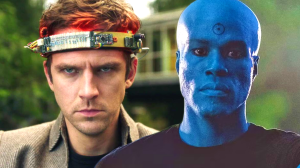Daggerheart incorporates a collaborative worldbuilding model that not only instantly makes players invested in the world that they’re about to explore, but also takes a lot of the heavy lifting off of GMs. One way that Daggerheart differs from Dungeons & Dragons, Pathfinder, and other campaign-length fantasy RPGs is that it encourages a collaborative approach to worldbuilding. The game uses a worldbuilding system inspired in part by The Quiet Year and uses it for the foundation for an entire campaign, encouraging all players to help come up with the world, literally filling in a map with story hooks and complications that they’ll have to face over the course of the game.
Videos by ComicBook.com
Typically, Dungeons & Dragons and other similar games encourages grafting together the world of the game with the backstories of the player. Often times, players will provide their GM with a backstory that can be mashed together with either the pre-made campaign setting or used as some kind of foundation for the world that the GM is in the process of building. Daggerheart’s approach is more collaborative and improvisational in nature, keeping with the general tone of the game. Character creation comes with a series of optional prompts that can be used to build a backstory, with players encouraged to come up with specific location names and details about their life before the campaign starts. During a pre-campaign session, players are then handed a map (Daggerheart comes with three pre-generated maps) and told to fill it out with the locations mentioned in their backstory along with location names from a pre-generated picklist. Players are encouraged to provide the GM about details of each location, giving them defining characteristics, populating them with monsters or NPCs, and generally offering up plot hooks that the GM uses to craft a campaign setting.
Putting worldbuilding into the player’s hands comes with a few distinct advantages. It makes the players feel like equal partners in the campaign and they’re more likely to understand the “rules” of the world and more importantly follow them if they had a hand in creating them. One of the biggest challenges to establishing a long-length campaign is player buy-in for the world, and having the players create the worldbuilding creates an instant level of buy-in for the players.
Additionally, making worldbuilding part of gameplay prevents the GM from “wasting” their time trying to pre-build the world in a satisfactory way for their players. A common pratfall for players is that they try to craft a fully-fleshed out world ahead of the campaign, coming up with information that players will often never need to know about the campaign setting. By having the players build out the world of the campaign themselves, it not only saves the GM time, it also directs the GM on what areas they should further build out. If the players are interested in the pantheon of the world, a GM knows that they can incorporate inter-religious conflict or bring the gods themselves as players into the game. If the players craft a detailed political heirarchy, it sets up a campaign filled with politics and intrigue.
Even if GMs have an idea of a specific type of campaign they’d like to run, Daggerheart’s campaign-building recommendations and worldbuilding rules can still provide a great collaborative experience. For my personal campaign of Daggerheart, I knew that I wanted to build out a “skyship campaign” where the players find a skyship and use it to explore a remote nation of sky islands above their home. I generated a basic map and provided them with the basic framework of the world – there’s three landbound nations, a handful of known skyships that soar through the sky, and a large unpopulated region of the landmass to the west. I then asked the players a series of questions about each of the three nations, the skyships themselves, and a few other foundational incidents that occurred in the history of that world.
The players took those questions as prompts and riffed off each other for the remainder of the night, coming up with a world with a few surprising twists that I would have never thought of on my own. They crafted an entire history of conflict between the three landbound nations, gave each nation a distinct culture of its own, and even came up with the calamity that they’ll eventually have to stop over the course of the campaign. They even provided me with the story hook for the first adventure – the four player characters are working together to find a lost magical item that they plan to trade to get information on a sky captain’s next planned landing point.
Collaborative worldbuilding isn’t a new concept in tabletop RPGs and there are plenty of established alternatives to collaborative worldbuilding for players not interested in trying out Daggerheart. However, one of the things I’ve enjoyed the most about the Daggerheart experience thus far is that it has opened up an alternative style of GMing that’s more suited to my busy schedule and resdistributes the creative heavy lifting that comes with running a campaign onto every player at the table. And with that, my players seem more excited to explore the world of the campaign than they have in years.








